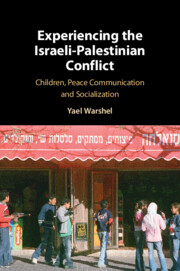Book contents
- Experiencing the Israeli-Palestinian Conflict
- Experiencing the Israeli-Palestinian Conflict
- Copyright page
- Dedication
- Contents
- Figures
- Tables
- Acknowledgments
- Note on the Text
- Abbreviations
- Introduction
- Part I The Encoding and Production of Israeli and Palestinian Sesame Street
- Introduction to Part I: Encoding and Production Methodologies
- 1 The Israeli-Palestinian Ethno-political Nationalist Conflict, the Arab-Israeli Multistate Conflict and Israeli and PalestinianSesame Street’s Disengagement with These Conflicts
- 2 The Modern World, or Interstate, System
- 3 The Encoding Process for Seasons One and Two of Israeli and Palestinian Sesame Street
- Part II Audience Reception of Israeli and Palestinian Sesame Street
- Part III Situating the Reception of Israeli and Palestinian Sesame Street in Mundane, Intractable Conflict Zone Practices
- Part IV Conclusions and Recommendations to Improve Peace Communication Research, (Evidence-Based) Practice and Conflict Intractability Interpretation
- Book part
- References
- Index
- Plate Section (PDF Only)
2 - The Modern World, or Interstate, System
from Part I - The Encoding and Production of Israeli and Palestinian Sesame Street
Published online by Cambridge University Press: 08 July 2021
- Experiencing the Israeli-Palestinian Conflict
- Experiencing the Israeli-Palestinian Conflict
- Copyright page
- Dedication
- Contents
- Figures
- Tables
- Acknowledgments
- Note on the Text
- Abbreviations
- Introduction
- Part I The Encoding and Production of Israeli and Palestinian Sesame Street
- Introduction to Part I: Encoding and Production Methodologies
- 1 The Israeli-Palestinian Ethno-political Nationalist Conflict, the Arab-Israeli Multistate Conflict and Israeli and PalestinianSesame Street’s Disengagement with These Conflicts
- 2 The Modern World, or Interstate, System
- 3 The Encoding Process for Seasons One and Two of Israeli and Palestinian Sesame Street
- Part II Audience Reception of Israeli and Palestinian Sesame Street
- Part III Situating the Reception of Israeli and Palestinian Sesame Street in Mundane, Intractable Conflict Zone Practices
- Part IV Conclusions and Recommendations to Improve Peace Communication Research, (Evidence-Based) Practice and Conflict Intractability Interpretation
- Book part
- References
- Index
- Plate Section (PDF Only)
Summary
This chapter offers a theoretical overview of the modern world system: a system ordered by states rather than nations. The normative acceptance of the unit and design of the state internal to this, the interstate system, proscribes that people should live sedentarized lives within clearly demarcated state borders, governed by statebearing nations ruling over them. Sesame Street’s adaptation of the interstate system, in turn, meant that Israeli citizens (Jewish and Palestinian citizens of the state of Israel) were bound to their street-state, Rechov Sumsum, and later, Sippuray Sumsum, and Palestinian citizens (Palestinians citizens of the non-state institution of the Palestinian Authority), to Shara’a Simsim, and later, Hikayat Simsim. If citizens crossed one-street-state into the other, the assumption was that they would necessarily return “home” to their own bordered street-state.
- Type
- Chapter
- Information
- Experiencing the Israeli-Palestinian ConflictChildren, Peace Communication and Socialization, pp. 82 - 87Publisher: Cambridge University PressPrint publication year: 2021

